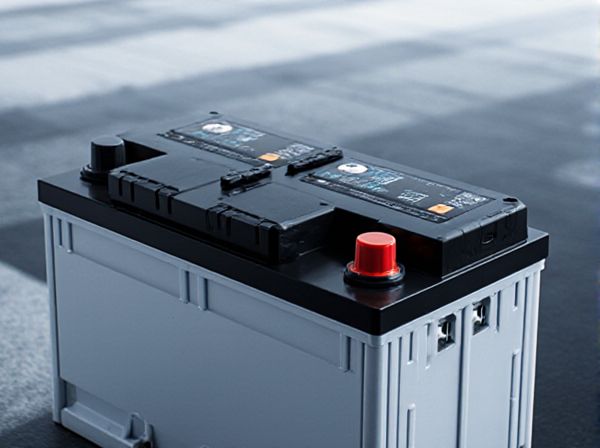
Photo illustration: Lithium Iron Phosphate vs Nickel Metal Hydride
Lithium Iron Phosphate (LiFePO4) batteries offer longer cycle life, enhanced thermal stability, and lighter weight compared to Nickel Metal Hydride (NiMH) batteries. Your choice depends on application needs, with LiFePO4 excelling in high-performance and longevity, while NiMH provides a more affordable option with moderate energy density. Understanding these differences ensures optimal performance and efficiency for your energy storage or portable device requirements.
Table of Comparison
| Feature | Lithium Iron Phosphate (LiFePO4) | Nickel Metal Hydride (NiMH) |
|---|---|---|
| Energy Density | 90-160 Wh/kg | 60-120 Wh/kg |
| Cycle Life | 2000-5000 cycles | 500-1000 cycles |
| Weight | Lighter | Heavier |
| Thermal Stability | High (Safer under heat) | Moderate |
| Charging Speed | Faster | Slower |
| Environmental Impact | Lower Toxicity | Contains Heavy Metals |
| Cost | Higher Initial Cost | Lower Initial Cost |
| Applications | Electric Vehicles, Solar Storage | Hybrid Vehicles, Consumer Electronics |
Introduction to Battery Technologies
Lithium Iron Phosphate (LiFePO4) batteries offer high thermal stability, longer cycle life, and safer chemistry compared to Nickel Metal Hydride (NiMH) batteries, which feature lower energy density but have been widely used in hybrid vehicles. LiFePO4 batteries provide consistent voltage output and low internal resistance, making them suitable for electric vehicles and renewable energy storage systems. NiMH batteries support fast charging and better performance at low temperatures, but their heavier weight and higher self-discharge rate limit their efficiency in large-scale applications.
Overview of Lithium Iron Phosphate (LiFePO4)
Lithium Iron Phosphate (LiFePO4) batteries feature a stable olivine crystal structure, offering high thermal stability and enhanced safety compared to Nickel Metal Hydride (NiMH) batteries. LiFePO4 cells provide a longer cycle life exceeding 2000 cycles, with a nominal voltage of 3.2 volts per cell and energy density around 90-120 Wh/kg. These batteries exhibit excellent charge retention, low self-discharge rates, and superior performance under high-current discharge, making them ideal for electric vehicles, solar energy storage, and portable electronics.
Overview of Nickel Metal Hydride (NiMH)
Nickel Metal Hydride (NiMH) batteries offer a higher energy density compared to traditional Nickel-Cadmium cells, making them suitable for various portable electronics and hybrid vehicles. NiMH cells typically operate at 1.2 volts per cell and feature a relatively low self-discharge rate, enhancing their reliability for medium- to high-drain applications. Their widespread use in consumer electronics and automotive hybrid systems underlines their balance of cost-efficiency, power delivery, and environmental impact compared to Lithium Iron Phosphate batteries.
Energy Density Comparison
Lithium Iron Phosphate (LiFePO4) batteries offer an energy density typically ranging from 90 to 160 Wh/kg, significantly higher than Nickel Metal Hydride (NiMH) batteries, which usually provide around 60 to 120 Wh/kg. This higher energy density enables LiFePO4 cells to store more energy per unit weight, making them preferable for applications requiring lightweight and long-lasting power sources. NiMH batteries, while safer and more environmentally friendly, fall short in energy density, limiting their use in high-demand devices compared to LiFePO4 technology.
Cycle Life and Longevity
Lithium Iron Phosphate (LiFePO4) batteries offer significantly longer cycle life, typically ranging from 2,000 to 5,000 cycles, compared to Nickel Metal Hydride (NiMH) batteries which generally last around 500 to 1,000 cycles. The enhanced longevity of LiFePO4 batteries stems from their stable chemical composition, making them ideal for applications requiring frequent charge-discharge cycles. NiMH batteries tend to degrade faster due to higher self-discharge rates and electrode material fatigue, limiting their lifespan in high-demand uses.
Charging and Discharging Performance
Lithium Iron Phosphate (LiFePO4) batteries offer superior charging and discharging efficiency with higher charge acceptance and lower internal resistance compared to Nickel Metal Hydride (NiMH) batteries. LiFePO4 cells maintain stable voltage throughout discharge, providing consistent energy output and longer cycle life, whereas NiMH batteries experience voltage decline affecting performance. Optimal charging of LiFePO4 involves precise current control and temperature monitoring, resulting in faster recharge times and enhanced longevity over NiMH counterparts.
Safety and Thermal Stability
Lithium Iron Phosphate (LiFePO4) batteries exhibit superior safety and thermal stability compared to Nickel Metal Hydride (NiMH) batteries due to their inherently stable phosphate-based cathode structure, which reduces the risk of thermal runaway and fire. LiFePO4 batteries maintain consistent performance under high temperatures and are less prone to overheating, making them ideal for applications requiring robust thermal management. In contrast, NiMH batteries are more susceptible to heat-related degradation and thermal instability, limiting their safety profile in demanding environments.
Environmental Impact and Sustainability
Lithium Iron Phosphate (LiFePO4) batteries exhibit a lower environmental impact compared to Nickel Metal Hydride (NiMH) counterparts due to the abundance and non-toxic nature of iron and phosphate materials, reducing hazardous waste during disposal. LiFePO4 batteries offer longer cycle life and higher thermal stability, promoting sustainability through extended usability and decreased frequency of replacements, which lowers overall resource consumption. In contrast, NiMH batteries contain rare metals like nickel and cobalt, whose mining processes contribute to significant ecological degradation and raise concerns about supply chain sustainability.
Cost and Market Availability
Lithium Iron Phosphate (LiFePO4) batteries generally offer a lower cost per cycle and longer lifespan compared to Nickel Metal Hydride (NiMH) batteries, making them more cost-effective over time. LiFePO4 batteries are increasingly available in automotive and renewable energy markets, supported by growing demand and advancements in manufacturing. NiMH batteries maintain market presence primarily in hybrid vehicles and niche applications but face declining availability as LiFePO4 technology becomes more dominant.
Best Applications and Use Cases
Lithium Iron Phosphate (LiFePO4) batteries excel in electric vehicles, solar energy storage, and power tools due to their long cycle life, thermal stability, and high discharge rates. Nickel Metal Hydride (NiMH) batteries are preferred for hybrid electric vehicles, portable electronics, and medical devices, offering moderate energy density and strong performance over varied temperature ranges. LiFePO4 suits applications demanding safety and durability, while NiMH is ideal for devices needing reliable, maintenance-free power in diverse environments.
 caratoz.com
caratoz.com